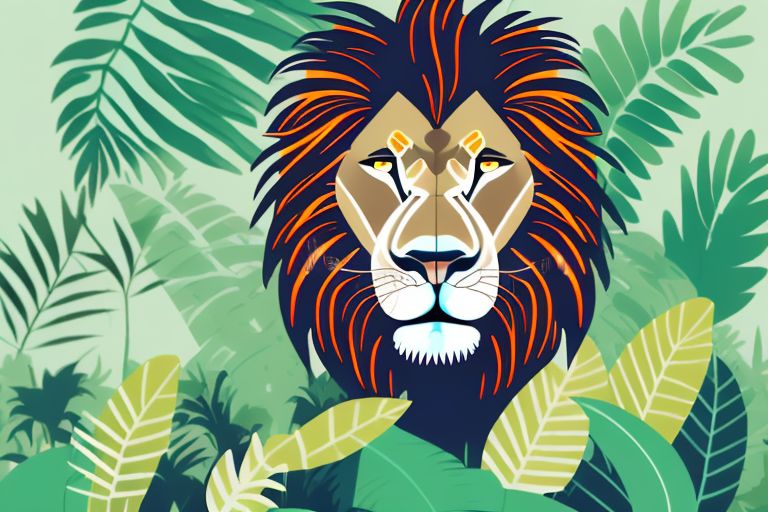Lions have always fascinated us with their majestic roar, which is often considered a symbol of strength, power, and royalty. But there’s much more to these sounds than we may have thought. In this article, we’ll delve into the art of lion roaring and explore the fascinating language of the king of the jungle, from its meanings to its symbolism, art, science, and even body ink.
In addition to vocalizations, lions also use body language and scent marking to communicate. For example, they may rub their heads or bodies against each other to reinforce social bonds and mark their territories with urine or feces to deter intruders and attract mates. Lions can also communicate through facial expressions, such as snarling, blinking, or raising their eyebrows, as well as through physical gestures, such as head-bobbing, tail-flicking, or pawing.
Interestingly, lion communication is not limited to their own species. Lions can also communicate with other animals, such as hyenas, leopards, and even humans. For instance, lions may use warning calls or aggressive displays to discourage potential threats from approaching, or they may approach humans out of curiosity or habituation. However, such interactions can be risky for both lions and humans, as they can lead to conflicts, injuries, or even fatalities.
Moreover, lion communication is not static or universal. It can vary depending on the ecological, social, and cultural context in which lions live. For instance, lions in savannah habitats may have different vocalizations and behaviors than lions in forest or desert habitats, as they face different challenges and opportunities. Similarly, lions in captivity may exhibit different communication patterns than lions in the wild, as they are exposed to different stimuli and social structures.
Despite the complexity and diversity of lion communication, there is still much to learn about this fascinating topic. By studying lions in their natural habitats and in captivity, researchers can shed light on the evolution, function, and conservation of this iconic species, as well as on the broader issues of animal communication and cognition.
The Science Behind the Roar: Uncovering the Meaning Behind Lion Roaring
Roaring is not only an art but also a science. For decades, scientists have been studying lion vocalizations to understand their acoustic properties, evolutionary history, and cultural significance. By analyzing the acoustics of roars, they can identify individual lions, detect their age and sex, and even assess their genetic diversity and inbreeding.
But why do lions roar? Roaring is a form of long-distance communication that serves multiple purposes. One of the main functions of roaring is to establish and maintain social bonds within a pride. Lions use different types of vocalizations, including roars, grunts, moans, and growls, to convey information about their identity, location, and emotional state. Roars are particularly effective for this purpose because they can travel up to five miles in open savannah and up to two miles in dense forest.
Roars can also serve as a territorial display to warn other lions or predators to stay away from their territory. Male lions, in particular, use their roars to announce their presence and dominance to other males and to attract females. Female lions also roar, but they tend to use softer and shorter roars to communicate with their cubs and other females.
Interestingly, the acoustic structure of lion roars can vary depending on the lion’s social status, age, and reproductive condition. For example, dominant males tend to have deeper and more powerful roars than subordinate males, which may reflect their larger body size and higher testosterone levels. Similarly, female lions in estrus produce longer and more frequent roars than non-estrous females, which may signal their reproductive readiness to males.
Roars can also reveal the ecological and environmental factors that shape the lion’s vocal behavior. For example, lions living in dense vegetation or near noisy human activities tend to roar more frequently and with a broader frequency range than those in open or quiet areas. Roars can also vary depending on the time of day, the season, and the weather conditions. By mapping the spatial and temporal patterns of lion roars, researchers can create a soundscape of the landscape and monitor changes in the lion population and habitat.
In summary, lion roaring is a complex and multifaceted behavior that reflects the lion’s social, ecological, and evolutionary context. By studying lion vocalizations, scientists can gain insights into the lion’s behavior, ecology, and conservation needs, and ultimately help to protect this iconic species for future generations.
Lion Roaring Clipart: Capturing the Majesty of Lions in Digital Art
Roaring is not only a natural sound but also a cultural motif that has inspired various forms of art, from sculptures and paintings to tattoos and digital graphics. One popular type of lion art is clipart, which features stylized or realistic depictions of lions in roaring poses, often in combination with other elements such as flames, crowns, or shields.

Lion roaring clipart can be used for a variety of purposes, such as logos, posters, banners, or social media graphics. They can convey different themes and moods, such as power, courage, passion, or freedom, and appeal to different audiences, from sports fans to animal lovers. Some lion clipart websites offer free or paid downloads of high-quality images that can be customized and resized to fit any design project.
Uncovering the Art of Roaring: Investigating the Meaning Behind the King of the Jungle’s Roar
Roaring is not only a sound but also an art form. Some cultures have revered the lion’s roar as a sacred or mystical expression of divine or supernatural power. In ancient Egypt, lions were often depicted with the sun and associated with gods and goddesses, such as Sekhmet, the lioness-headed goddess of war and healing. In Hindu mythology, the lion is the vehicle of Durga, the warrior goddess, and symbolizes courage and righteousness.
In some African tribes, lion roaring is not only a way to communicate with each other but also a way to communicate with the ancestors, the spirits, and the universe. The Maasai people, for instance, have a tradition of lion hunting, but they also respect and honor lions as sacred animals that represent strength, bravery, and leadership. They believe that a lion’s roar can summon the rain, bless the village, or warn the tribe of danger or change.
Lion Roaring Tattoo: Symbolizing Strength and Royalty in Body Art
Roaring is not only an inspiration but also a motif for body art. Many people choose lion roaring tattoos to express their admiration for the lion’s qualities and their own values, such as courage, loyalty, and pride. Lion tattoos can come in different styles and designs, from realistic portraits to abstract or tribal patterns.
Some popular lion roaring tattoo designs include a lion head with an opened mouth, a lion’s face with a crown or a mane, a lion’s paw or claw, or a lion roaring in front of a sunset or a cityscape. Lion tattoos can be placed on different body parts, such as the chest, the back, the arm, the leg, or the neck, and can vary in size, color, and detail. A lion roaring tattoo can be a bold and impressive statement that symbolizes strength, power, and royalty.
Lion Roaring Drawing: Showcasing the Beauty and Power of Lions in Art
Roaring is not only a motif but also a theme for visual art. Many artists have tried to capture the beauty and power of lions in drawings, paintings, and sketches, using different techniques and styles that range from photorealism to abstract expressionism. Lion roaring drawings can be found in art galleries, museums, and online platforms, and can be used for various purposes, such as illustrations, prints, or merchandising.

Some famous lion roaring drawings include the Lion of Lucerne, a relief carving in Switzerland that portrays a dying lion roaring in pain and defiance, and the Four Lions of the Colosseum, a set of ancient Roman sculptures that depict roaring lions fighting gladiators.
Other lion artists include Simon Combes, a wildlife painter known for his realistic and detailed lion portraits, Kenyan artist Patrick Kinuthia, who uses bright colors and geometric shapes to depict lions in a contemporary style, and Japanese artist Kawanabe Kyosai, who created whimsical and surreal depictions of lions and other animals.
Lion Roaring Wallpapers and Ringtones
Roaring is not only a motif but also a sound effect that can enhance the visual or audio experience of your device. Many lion roaring wallpapers and ringtones are available on the internet, for free or for a fee, that can customize your smartphone, tablet, or computer. These wallpapers and ringtones can feature different types of lion roars, such as aggressive, friendly, or expressive ones, and can be accompanied by other sound effects, such as jungle noises or African drums.
Some popular lion roaring wallpapers and ringtones include a lion’s face with a roaring mouth, a lion’s head in a crown, or a lion’s silhouette against a sunset or a city skyline. Lion roaring ringtones can be set to play when you receive a call, a message, or a notification, and can add a touch of personality and uniqueness to your device. Lion roaring wallpapers can be used to beautify your device’s background, lock screen, or app icons, and can be enjoyed by everyone who admires the king of the jungle.
Lion Roaring Sound: The Raw Power of the King of the Jungle
Roaring is not only a symbol but also a sensation that can evoke different emotions and reactions in different people. Listening to lion sounds can be a thrilling and mesmerizing experience that transports us into the heart of the African savannah, where lions roam and rule.
Lion roaring sounds can be found in various forms of media, from documentaries and movies to music and games. They can also be downloaded from various sources online, such as YouTube channels, wildlife websites, or sound archives. Some lion roaring sounds are isolated and pure, while others are mixed with other sounds, such as vocalizations, footsteps, or background noise.
How to Draw a Lion Roaring?
Roaring is not only an inspiration but also a skill that can be learned and practiced by anyone who loves art. Whether you’re a beginner or an experienced artist, you can try your hand at drawing a lion roaring using a step-by-step guide that can help you master the basic shapes, proportions, and details of the lion’s head and mouth.
Some tips for drawing a lion roaring include starting with a rough outline of the head, adding the mane, the eyes, and the nose, and then adding the mouth and the teeth. It’s also important to pay attention to the position and shape of the ears, which can convey different emotions and angles. By practicing different poses and expressions, you can develop your own style and technique for drawing lions and other animals.
Lion Roaring Sounds: Unique and Memorable Audio Experience
In conclusion, the art of lion roaring is a fascinating and multidimensional topic that combines science, culture, and aesthetics. Lion roaring sounds have inspired various forms of art, from body ink and paintings to wallpapers and ringtones, and have become an iconic and memorable symbol of the king of the jungle’s raw power and majesty.
Whether you admire lions for their beauty, strength, or symbolism, or simply enjoy their sounds and images, the art of lion roaring is a precious and timeless expression of our passion for nature and creativity.










